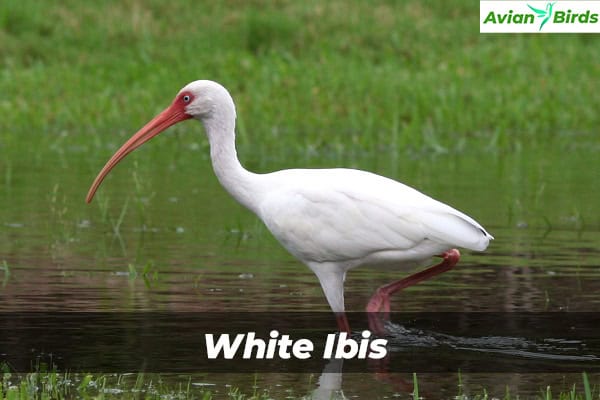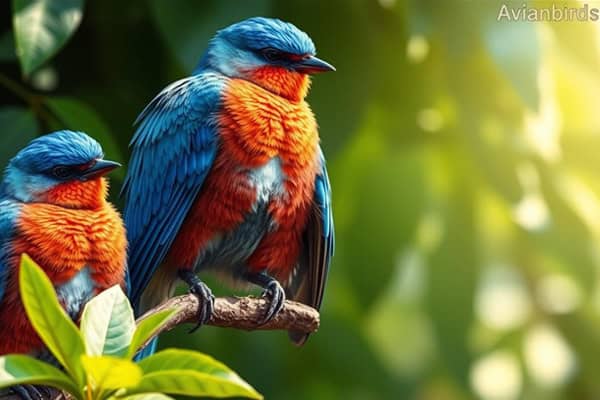Top 10 Types Of Ibis (ID Guide With Pictures)
Do you love the types of Ibis in the world? Ever wondered about the world of ibises? These birds, with their unique bills and habitats, are a treat for bird lovers and nature fans. We’ll explore the top 10 types of ibis, sharing details, pictures, and fun facts about their lives. From the famous white ibis to the majestic crested ibis, get ready to see the amazing variety of these birds.
If you love birds or just like learning about them, this guide is for you. We’ll take you on a trip to learn about the special traits, homes, and ways of these birds. Get ready to learn more about the ibis and appreciate these wetland birds even more.
Here we’ll learn about 10 different types of Ibis in the world
Introduction to the Fascinating World of Ibis
The ibis family includes many wading birds known for their long, curved bills. They are closely tied to wetland ecosystems. With over 20 species worldwide, they are key indicators of wetland health. By watching ibis populations, we learn about the health of their wetland homes.
“Ibises are like the canaries in the coal mine for wetlands – their presence and numbers can tell us a lot about the overall health of these vital ecosystems.”
Learning about ibis helps us understand our planet’s wetlands better. It shows us why we must protect these habitats. By appreciating these birds, we see the value of preserving life on Earth.
The Iconic White Ibis
The white ibis is a standout in the ibis family. It brightens the southeastern United States with its white feathers, black-tipped wings, and red legs and bill. These birds are a treat for birdwatchers and nature lovers.

Identification Features
Adult white ibises stand out with their white feathers and black wingtips. Juveniles show a mix of white and brown feathers. They are easy to spot with their long, curved bills and black wingtips.
Range and Habitat
White ibises live in coastal and inland wetlands in the southeastern United States. They’re common in Florida and along the Gulf Coast. These birds love marshes, swamps, and shallow waters, where they hunt for insects and small aquatic animals.
Behavior and Diet
White ibises have a special way of eating, using their long bills to search for food in the mud and water. They often feed in groups, helping each other find food. Their diet mainly includes insects, crustaceans, and small fish, which they skillfully catch from the wetlands.
“The white ibis is a true icon of the southeastern wetlands, captivating all who witness its graceful movements and striking appearance.”
Distinguishing the Glossy Ibis from the White-Faced Ibis
As bird lovers, knowing how to tell apart the glossy ibis and white-faced ibis is key. They look similar, especially outside their bright breeding colors. But, paying attention to details lets us tell them apart with ease.
Distinguishing Characteristics
The glossy ibis and white-faced ibis look alike at first glance. Yet, they have clear differences. Here’s what to look for:
- Bill color: The glossy ibis has a dark, blue-based bill, while the white-faced ibis has a lighter-colored bill.
- Eye color: The glossy ibis has dark eyes, while the white-faced ibis has striking red eyes.
- Leg color: The glossy ibis has gray to pale pink legs, while the white-faced ibis has pink to red legs.
- Facial markings: The white-faced ibis has a distinctive white line around its red face, which the glossy ibis lacks.
Breeding Plumage
In breeding season, the glossy ibis and white-faced ibis stand out more. The glossy ibis gets a deep, shiny look almost like black, with a gray bill and dark eyes. The white-faced ibis turns chestnut-colored, with a light bill, red eyes, and a white line on its face.
Non-Breeding Plumage
Even when they’re not in their bright breeding clothes, we can still tell them apart. The glossy ibis keeps its dark, blue-based bill with a narrow white line. The white-faced ibis keeps its red eyes and some red on the bill.
Knowing these differences helps us spot the glossy ibis and white-faced ibis with confidence. We can then enjoy the beauty of these wetland birds.
Exploring Other Intriguing Ibis Species
The white ibis, glossy ibis, and white-faced ibis are well-known, but there are many more fascinating ibis species. From the hadada ibis to the elusive são tomé ibis, each one offers a glimpse into the world of these wading birds.
The hadada ibis, from Africa, makes a sound like “ha-da-dah,” earning it the “voice of the African night” nickname. It stands out with its bronze-green feathers and long, curved bill in wetlands.
- The olive ibis, in central Africa, has olive-green feathers that help it hide in forests.
- The spot-breasted ibis, unique to Madagascar, has a white-spotted chest and a long, curved bill.
- The são tomé ibis, found only on São Tomé, is rare and not well-studied.
Learning about the ibis family helps us appreciate these birds and their roles in wetlands. The hadada’s call and the são tomé ibis’ mystery show how each species is special.
Discovering more about the ibis family shows us why we must protect these wetland birds. By exploring the variety of ibis species, we learn to value the natural world more.
Types of Ibis
The ibis family is a group of wading birds with over 20 species across the globe. Each ibis has its own unique traits, like colorful feathers and special bills. They live in different places and eat in different ways. Learning about these birds helps us understand their important roles in nature.
Some of the key types of ibises include:
- White Ibis
- Glossy Ibis
- White-Faced Ibis
- Crested Ibis
- Scarlet Ibis
- Hadada Ibis
- Olive Ibis
- São Tomé Ibis
- Spot-Breasted Ibis
The ibis species list shows the amazing variety of ibises worldwide. Each species has adapted to live in its own special place. By watching and identifying these birds, we can see what makes them so interesting.
“Ibises are a fascinating group of birds, each species with its own remarkable adaptations and characteristics. Exploring their diversity is a true delight for any birdwatcher or nature enthusiast.”
Looking into the different ibises helps us value our wetland ecosystems more. These birds are important signs of how healthy the environment is. Keeping them safe is key to keeping our natural habitats balanced.
The Majestic Crested Types of Ibis
The crested ibis is a captivating bird with its unique crest and striking look. It’s known for its all-white feathers, bright red bill and legs, and the elegant crest on its head. This makes it a sight to see.
Unique Features
This bird stands out with its long, slender red bill and legs. Its pure white feathers contrast well with these bright red parts. The elegant crest on its head adds a regal touch to its look.
Distribution and Habitat
The crested ibis live in East Asia, mainly in China and Japan. They love wetlands like marshes, estuaries, and shallow lakes. Here, they find small aquatic creatures and insects to eat.
This bird was once in danger but is now a success story in conservation. Thanks to efforts to protect it, its numbers are slowly getting better. This gives hope for its future.
“The crested ibis is a true symbol of the beauty and resilience of the natural world. Its recovery is a testament to the power of conservation efforts and the importance of protecting our precious wetland ecosystems.”
The Striking Scarlet Ibis
The scarlet ibis is a standout among the many ibis species worldwide, known for its bright, flame-red feathers. Found in northeastern South America, this bird is a sight to see. Its bold look draws in bird lovers and nature fans.

This bird gets its bright color from eating foods full of carotenoid pigments. These pigments come from the crustaceans and small sea creatures they eat. This makes its feathers a deep scarlet color. This bright look helps people tell it apart from other ibis.
The scarlet ibis lives in mangrove swamps and wetlands by the coast. It loves the rich waters for finding food like crabs, shrimp, and small fish. Its long, curved beak is great for digging in the mud and shallow water for food.
“The scarlet ibis is a true marvel of nature, captivating all who are lucky enough to witness its brilliant plumage in the wild.”
The scarlet ibis is not just beautiful; it’s also vital to its ecosystem. These birds act as wetland indicators, showing the health of their habitats. Watching their numbers and actions helps scientists understand the condition of these important wetlands.
If you love birdwatching or just enjoy nature, the scarlet ibis will amaze you. Its striking look and key role in nature make it a standout among ibis species.
Read Our Previous Articles:
Conservation Status and Threats
Many types of ibis species are doing well, with their numbers stable or growing. But, some ibis faces big challenges in conservation. It’s key to know the current status and threats to these wetland birds for their survival.
Endangered and Rare Ibis Species
The northern bald ibis is critically endangered and nearly gone from the wild. This shows how urgent conservation efforts are needed. The são tomé ibis is also rare, making it vital to keep an eye on its habitat.
- The northern bald ibis is a critically endangered species with a population now considered extinct in the wild.
- The são tomé ibis is a rare ibis species, underscoring the need for habitat conservation.
Threats to ibis include habitat loss and degradation. These can come from urban growth, farming, and climate change. To protect endangered ibis and rare ibis, we must work on restoring habitats and using sustainable land practices.
| Ibis Species | Conservation Status | Primary Threats |
|---|---|---|
| Northern Bald Ibis | Critically Endangered | Habitat Loss, Hunting |
| São Tomé Ibis | Endangered | Habitat Degradation, Small Population Size |
| Slender-Billed Ibis | Critically Endangered | Habitat Loss, Hunting, Disturbance |
By keeping an eye on ibis conservation and tackling the ibis threats, we can help these wetland birds and their homes last longer.
“Protecting the habitats of endangered and rare ibis species is crucial for preserving these remarkable birds and the delicate wetland ecosystems they represent.”
Ibis Behavior and Feeding Habits
Ibis’s behavior is truly fascinating. These wading birds are known for their long, curved bills. They use these to search for food in wetlands. They often forage in groups, working together to find and catch small aquatic creatures and insects.
Ibises move slowly, which suits their life in wetlands. They can reach shallow water easily, helping them find food. This makes them important for checking the health of wetlands.
Watching an ibis move through marshes is beautiful. Seeing a flock forage together shows their importance in nature. By protecting their homes, we help these birds and the ecosystems they live in.
Frequently Asked Questions About Types of Ibis
Q1. How many ibis are there?
There are about 28 species of ibis.
Q2. What is the rarest ibis?
The Giant Ibis is considered the rarest ibis.
Q3. What is the difference between glossy ibis and hadada ibis?
The Glossy Ibis has iridescent green and purple feathers, while the Hadada Ibis has a duller, brownish-gray plumage and is known for its loud, distinctive call.
Q4. What are the different names for ibis?
Ibis are also known by names such as the Sacred Ibis, Scarlet Ibis, and Straw-necked Ibis, among others.







